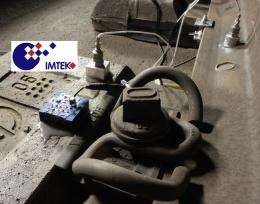August 8, 2011 feature
Trains’ vibrations could provide power for monitoring tunnels

(PhysOrg.com) -- Traffic tunnels are often built in some of the most rugged and remote areas, which subjects them to extreme environmental forces while making them difficult to access. Ideally, the structural health of tunnels could be monitored in a way that requires minimal human maintenance while ensuring that the tunnels are consistently safe to drive through.
In a typical structural health monitoring system, an array of sensors placed throughout the tunnel or other structure provides continuous monitoring, giving an early warning sign of any problems, such as damage due to corrosion or impact. When batteries are used to power the sensor arrays, replacing the batteries becomes an expensive and time-consuming endeavor.
With this drawback in mind, researchers are developing a power unit that harvests the vibrations from passing traffic to power the wireless sensor nodes of a structural health monitoring system for tunnels. The power harvesting unit could reduce maintenance costs and improve the performance of the sensor network.
The researchers, Martin Wischke and coauthors from the University of Freiburg in Germany, have published their study on the new power supply concept for monitoring systems in a recent issue of Smart Materials and Structures. The study is part of the AISIS project funded by the Federal Ministry of Education and Research.
“[Currently,] railway tunnels feature very few structural health monitoring devices,” Wischke told PhysOrg.com. “Our system can be easily mounted to any tunnel, whether it is a new building or an old one. The installation of the sensor nodes is quite easy, flexible, and time- and cost-effective, which are advantageous attributes compared to wired monitoring systems. Thus, our system is especially suited for refitting and upgrading older tunnels to improve security.”
When the researchers first started investigating the use of vibrations from passing vehicles as an energy source, they found that no detailed data on the vibrations in traffic tunnels was available. So to begin, they investigated the vibrations in two tunnels: the Pfander-tunnel, a road traffic tunnel near Bregenz, Austria; and the Lotschbergbasis-tunnel, a high-speed train tunnel in Switzerland. They placed acceleration sensors in both tunnels to measure the vibrations from passing traffic. In the road tunnel, the sensors were monitored for a 3-5-minute period every hour, while each passing train was monitored in the train tunnel (more than 500 trains total).
When analyzing the vibrations, the researchers found that they could determine which acceleration signals represented cars and which signals represented trucks in the road tunnel. In the train tunnel, they could determine each train’s structure, such as the number of axles and the wagon sizes. They could also identify passenger trains based on their smaller accelerations, which are a result of better wheels and suspensions to improve passenger comfort.
In terms of usable energy, the researchers found that only the vibrations in the train tunnel were sufficient for harvesting; vibrations at various locations along the road tunnel were too small to be useful due to vehicles’ suspensions and pneumatic tires. While the vibrations in the train tunnel were strongest directly on the railroad track, the researchers decided to forego mounting a vibration harvester on the rail because screw holes pose problems, such as causing cracks. Instead, the researchers mounted vibration harvesters on the railroad sleepers/ties due to the larger space and easier access, even though the vibration amplitudes are smaller there than at the rail.
The researchers then designed, fabricated, and tested a piezoelectric vibration harvester capable of harvesting vibrations across a broad frequency, since each train produces a slightly different frequency spectrum. The energy is then stored in a capacitor and supplied to the sensor system when needed. In order to ensure safe handling of the harvested energy, the researchers designed an ultra-low power control circuit that monitors the storage capacitor voltage and disconnects the sensor circuit from the capacitor if not enough energy is available. While other power control circuits exist that consume several microwatts to operate, the new circuit’s simple design enables it to run on a current of just 70 nA.
In the future, the researchers plan to make some improvements to the system, including expanding the harvested frequency spectrum and increasing the power output, and then prepare the system for industrial applications. In addition to energy harvesting, the system could be used in railway traffic surveillance, since details about the passing train (such as the quality of the wagon wheels and wagon weight) can be derived from the vibrations.
More information: M. Wischke, et al. “Vibration harvesting in traffic tunnels to power wireless sensor nodes.” Smart Mater. Struct. 20 (2011) 085014 (8pp). DOI:10.1088/0964-1726/20/8/085014
Copyright 2011 PhysOrg.com.
All rights reserved. This material may not be published, broadcast, rewritten or redistributed in whole or part without the express written permission of PhysOrg.com.




















